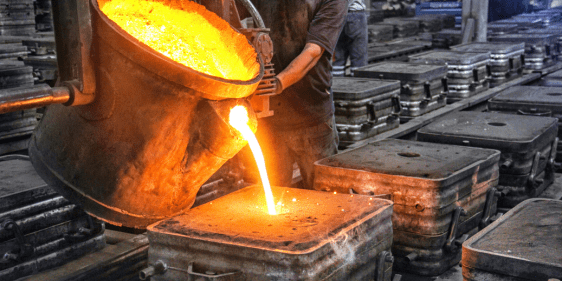Metal casting is a versatile manufacturing process that involves pouring molten metal into a mould to create complex shapes and components. This technique, dating back thousands of years, has evolved into a sophisticated method widely employed in modern industries.
The process begins with the creation of a mould, typically made of sand, ceramics, or other refractory materials, which is designed to form the desired shape.
The chosen metal, often aluminium, iron, or steel, is then melted at high temperatures and poured into the prepared mould. Once the metal solidifies, the mould is removed, and the final product is revealed.
There are different methods within casting, each offering different advantages. In this article, you will learn about die, lost wax, and gravity casting, as well as when you should choose which method.
Die casting-min.jpg?width=300&height=300&name=Focon%20(1)-min.jpg)
You choose die-cast parts because of the low unit price.
Unit costs are low. The tooling, however, is costly compared to other casting methods. That is why the production volume must be high to justify the tooling cost.
You reach high dimensional accuracy when choosing die casting. Your parts can have thin walls because of the high pressure used during the process. Furthermore, you can reach net shape products at high rates requiring little or no post-processing.
The surface finish is good with fine roughness between 0.8-3.2 um Ra – a fine-grained hard skin. This gives the part excellent strength but makes grinding or polishing challenging.
Smaller pieces can be manufactured using either multi-cavity die or miniature die casting.
Lost wax casting-min.jpg?width=300&height=300&name=Kongsberg%20Maritime%20(1)-min.jpg)
Lost wax casting is for when you want to reach complex geometries and tight tolerances.
It is ideal for reaching net shape or in near net shape, ultimately reducing the need for secondary processes. Especially, if high-quality surfaces are essential for your product, this is beneficial.
The process is widely used for pumps and valves because of their intricate shapes.
Gravity casting-min%20(1)%20(1).jpg?width=300&height=300&name=Louis%20Poulsen%205-xx-alu%20(1)-min%20(1)%20(1).jpg)
In gravity die casting, the molten metal is poured into a mould from above. The mould fills from the bottom and upwards, purely under gravitational force.
You should choose gravity casting if you need medium volume and the possibility of heat treating the parts to make them more robust.
Sand casting
Sand casting that involves creating a mould from compacted sand to produce metal components. This cost-effective method is particularly suitable for producing large and intricate parts with complex geometries.
The process by creating a mould of a special moulding sand. This sand is mixed with a binder to give it strength and stability. Molten metal is then poured into the mould. When the metal solidifies, you have a finished cast part.
Sand casting is advantageous for its simplicity, low production/tooling cost, and ability to obtain intricate shapes.




